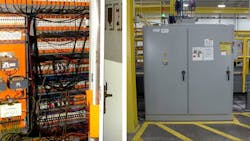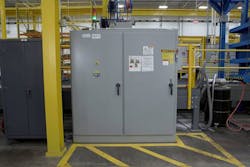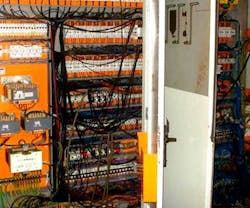At a Glance:
When striving for long-term sustainability, designers have latitude as to how complex a system they wish to design.
Build sustainability into every aspect of the control panel’s life—design, manufacturing, installation and maintenance.
Sustainability should be of utmost importance for all of us so that we can meet the needs of today without compromising the needs of tomorrow. Put more succinctly, we cannot continue using resources at current levels without shortchanging future generations. The world’s population, demand for resources and the cost of energy all continue to grow—which makes sustainable systems not only better for the world, but better for business.
But how does sustainable design impact a control panel? This can be equated to minimized equipment footprint, easy installation, low-to-no maintenance, and reduced installation time and costs.
It’s easy to think of going “green” with facility improvements such as more efficient lighting, reduced water consumption and minimized emissions. However, the machine building industry doesn’t usually think about the impact that control panels can have. Creating sustainable products is not just about tweaking a design here and there, but about adopting a new approach to product design that builds sustainability into every aspect of its life—design, manufacturing, installation and maintenance.
Although the word “sustainable” may invoke different modern-day connotations, the main target remains the same: to optimize resources. Specifically, the electrical systems that engineers design consume resources both during construction and throughout the life of the building. Although large parts of these systems’ designs are driven by building codes, these codes also contain some flexibility that allows designers to use fewer resources.
Let’s take a look at control panels of today and tomorrow, along with some of the key factors to consider when designing sustainable control panels.
Today’s Control Panel
An industrial control panel (ICP) is “an assembly of a systematic and standard arrangement of two or more components.” Those components could be motor controllers, overload relays, fused disconnect switches and circuit breakers, and related control devices including pushbutton stations, selector switches, timers, switches and control relays, with associated wiring, terminal blocks, pilot lights and similar components. Control panels are the brains of all automation projects and are vital for the optimal performance and reliability of connected systems.
However, these assemblies face new design challenges every day, including enhanced regularity requirements, advancements in control systems technology and new methods of design and fabrication.
A typical control panel that is ready for assembly includes point-to-point wiring from I/O devices and added wiring to pilot devices on the door. But, as modifications to the panels are made, design becomes more complex, cumbersome and eventually overcrowded. As more changes are made, the more complex the panel becomes; in turn, maintenance time is increased and the question of an applicable warranty comes into play. These factors combine to make it more difficult to incorporate changes and perform maintenance without interrupting the system and causing serious downtime.
Design for Tomorrow
Even though there are many codes and standards that mandate how controls should operate, designers have a lot of latitude as to how complex a system they wish to design when striving for long-term sustainability. The complexity of the system comes into play when thinking about long-term environmental implications.
The control panel design of tomorrow includes the usual consideration, depth and footprint of the panel, components to be installed, wiring, dimensions of components and cabling. But, there are emerging trends in control panel design that can make an impact on the future of the industry:
IoT/connectivity. A panel design that manages power distribution and enables equipment communications with the user
Sustainability. A design that would control costs: maintenance and operation, providing flexibility for system upgrades/enhancements, and complying with NEC and UL508A
Optimizing footprint. With the rise in population, the need for new and expanded infrastructure due to limited space availability is increasing. Designers are being asked to create smaller products and systems. In the case of a panel design, the goal can be met by reducing panel depth with shallower doors and panel footprint with more efficient components
3D prototype. Using 3D printing to develop a prototype that will help eliminate errors and omissions for the panel design
Aesthetics. Improve aesthetics by designing a cleaner and workable panel (e.g., reducing the amount of wiring)
By incorporating one or more of these trends, the design can be considered sustainable. But, what does that really mean? In a nutshell, it means that the system is now efficient and reliable. It will help reduce energy costs by easily identifying maintenance needs based on energy consumption, receive notifications that could save costs and reallocate machinery based on the energy profile.
- Efficient system: managing and reducing energy costs by incorporating IoT and sustainable design.
- Easy installation: adding “plug & play” components instead of cumbersome installation practices.
- Reliable system: peace of mind knowing that the sustainable design can support the customer system for years.
- Easy commissioning and start-up: the system is very easy to understand and commission with a quicker start-up and huge cost savings.
- Low maintenance: with the ability to monitor the system in real-time before costly repairs are needed and downtime is avoided.
In summary, a sustainable panel is designed for present and future needs in mind. Throughout the lifetime of the system, the sustainable design will control costs associated with maintenance and operation, while providing flexibility for system upgrades/enhancements while complying with regulations.
To achieve a sustainable design, decision makers must choose the right panel components that will dramatically reduce the overall panel cost and size in addition to minimizing escalating labor costs. You can incorporate pilot devices (including new, trendy pushbuttons) as an integral part of your connected and intelligent system for efficiency and reliability. Consider choosing intelligent and faster solutions to reduce wiring time and costs for easy installation, as well as commissioning and start-up. While saving material, time and labor costs, one can still have an aesthetically appealing panel.
Ceren Bacinoglu is product manager for pilot devices, Eaton. For more information on control panels, visit www.Eaton.com/industrialcontrol.


